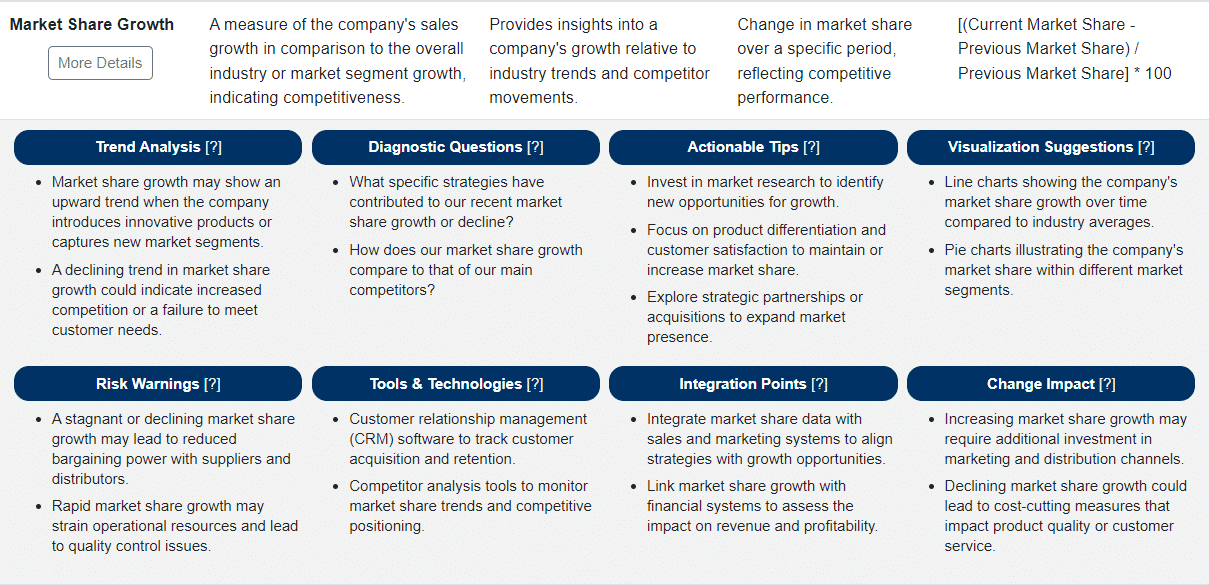Editor's Note: Take a look at our featured best practice, Cost Segregation Study: Multiple Property Class Analysis (Excel workbook). Accountants, accounting firms, and real estate property owners can all benefit from this cost segregation study (CSS) template. It makes the estimated benefit easy to figure out and has flexible assumptions for high level or detailed segregation analysis. You get a summary of cost [read more]
KPI Management: Competitive Benchmarking KPIs
* * * *

Competitive Benchmarking involves the comparison of an organization’s processes, performance metrics, and products against industry bests or best practices from other industries. For organizations seeking to gain a competitive advantage, understanding these benchmarks is crucial for setting goals, driving process improvement, and achieving excellence in performance.
This article will delve into the vital role of Competitive Benchmarking KPIs in empowering organizations to make data-driven decisions. Our discussion will focus on how these KPIs can illuminate an organization’s competitive position, facilitate strategic formulation, and pinpoint areas for operational enhancements. We aim to equip leaders with the insights needed to not only keep pace with their competitors but to surpass them, by leveraging the power of precise, actionable data.
Importance of Competitive Benchmarking
Competitive Benchmarking transcends traditional performance metrics by providing a relative understanding of where an organization stands in the competitive landscape. It is a strategic tool that highlights gaps, uncovers opportunities, and drives an organization’s approach to market leadership.
In an ever-evolving business environment, the importance of benchmarking cannot be overstated—it is the critical lens through which organizations can view and evaluate their strategies, operations, and overall performance. This strategic imperative has become easier in the modern age where data has been ubiquitous.
Challenges to Conducting Competitive Benchmarking
One of the most significant challenges organizations face is the ability to objectively assess their performance against competitors. Without an industry benchmark, it’s difficult to gauge success, identify areas of improvement, or recognize innovation opportunities.
Additionally, organizations struggle with the implementation of best practices that are not directly aligned with their operational framework or strategic goals. The KPIs associated with Competitive Benchmarking address these challenges by offering a structured approach to measure and compare critical aspects of performance, ensuring that organizations are not operating in a vacuum, but are continually improving in the context of the broader industry standards.
Top 10 Competitive Benchmarking KPIs
For organizations looking to refine their competitive edge, we have compiled the top 10 most important KPIs used in Competitive Benchmarking. These metrics provide a comprehensive view of how an organization stacks up against its peers and industry standards. These KPIs are selected from the Flevy KPI Library, a robust database of over 15,000+ KPIs.
1. Market Share Growth
- Definition: Measures the change in a company’s sales relative to the total market sales.
- Relevance: This KPI is a direct indicator of a company’s competitive performance and its ability to capture a larger portion of the market over time.
2. Competitive Sales Growth Rate
- Definition: Assesses the rate of sales growth in comparison to competitors.
- Relevance: Understanding how your sales growth compares to competitors can inform strategy and operational adjustments to accelerate growth.
3. Benchmarked Profit Margins
- Definition: Compares an organization’s profit margins with those of key competitors.
- Relevance: Profit margin benchmarking is crucial for assessing how well an organization is managing costs relative to competitors, which can inform pricing and cost management strategies.
4. Customer Satisfaction Benchmark
- Definition: Compares an organization’s customer satisfaction levels against industry or direct competitors’ benchmarks.
- Relevance: Ensures that the organization remains competitive in terms of customer service and support, which is vital for retention and brand reputation.
5. Return on Investment (ROI) Benchmarking
- Definition: Evaluates the efficiency of investment by comparing an organization’s ROI to that of its competitors.
- Relevance: ROI benchmarking helps in determining if an organization is generating competitive returns on its investments, guiding capital allocation decisions.
6. Customer Retention Rate
- Definition: The percentage of customers an organization retains over a given period, compared to competitors.
- Relevance: High retention rates relative to competitors indicate stronger customer loyalty and the effectiveness of engagement strategies.
7. Brand Equity Index
- Definition: A composite index of factors such as consumer recognition, loyalty, and brand perception, compared to competitors.
- Relevance: This KPI indicates the value of a brand in the competitive market and can influence marketing investment and strategy.
8. Earnings Before Interest and Taxes (EBIT) Margin Comparison
- Definition: The comparison of an organization’s EBIT margin with that of competitors.
- Relevance: Provides insight into an organization’s operational profitability and can drive strategies for cost reduction and efficiency improvement.
9. Capital Expenditure (CapEx) Efficiency
- Definition: Measures how effectively an organization is utilizing its capital expenditures compared to competitors.
- Relevance: Efficient CapEx utilization is indicative of strategic asset investment, which is essential for long-term competitiveness.
10. Market Position Rank
- Definition: The ranking of an organization within its market or industry based on various performance indicators compared to competitors.
- Relevance: Gives a clear indication of where an organization stands in the competitive landscape, which can impact investor relations and strategic planning.
To dig deeper into any of these KPIs, we invite you to explore the Flevy KPI Library, which allows you to drill down into 12 attributes for each KPI in the database. Here is an example for our top ranked KPI, Market Share Growth:
Case Studies and Success Stories
Gaining Market Share Through Targeted Customer Experience
A consumer electronics company was struggling to increase its market share in a highly competitive industry. To understand its position, the company focused on “Market Share Growth” and “Customer Satisfaction Benchmark” KPIs.
The organization initiated a comprehensive benchmark study to compare its customer satisfaction scores with those of the leading competitors. Based on the findings, the company implemented targeted improvements in customer service, product features, and user experience.
Outcome: Over the next two fiscal years, the organization not only improved its customer satisfaction scores by 15% but also saw a market share increase by 10%. The alignment of product and service improvements with customer expectations was key to this success.
Lessons Learned: This case underscores the importance of benchmarking customer satisfaction and market share. By understanding and acting on these KPIs, organizations can implement focused improvements that directly impact growth and competitive positioning.
Optimizing Investments for Greater Returns
A SaaS company aimed to enhance its competitive positioning by improving its ROI across its technology investments. The organization utilized “Return on Investment (ROI) Benchmarking” to compare its performance against industry standards.
The company analyzed its CapEx and operational expenses in relation to ROI, identifying underperforming investments and reallocating resources to high-performing areas. This strategic move was complemented by a shift towards agile methodologies to streamline product development and reduce time to market.
Outcome: The reallocation of investments and operational refinements led to a 20% increase in ROI, surpassing the industry benchmark. Additionally, the company moved up two positions in the “Market Position Rank,” indicating a stronger competitive stance.
Lessons Learned: The strategic realignment of investments based on ROI benchmarking can yield significant competitive advantages. By focusing on capital efficiency and operational agility, organizations can outperform competitors and improve their market position.
Additional Resources and Further Reading
Foremost, if you are in the process of selecting or refreshing your Corporate Strategy KPIs, take a look at the Flevy KPI Library. With over 15,000+ KPIs, our KPI Library is one of the largest databases available. Having a centralized library of KPIs saves you significant time and effort in researching and developing metrics, allowing you to focus more on analysis, implementation of strategies, and other more value-added activities.
Here are other KPI Strategy and KPI Management articles we’ve published:
- Principles of KPI Selection. This article breaks down the 8 guiding principles to KPI selection and provides several case studies on how to use these principles in practice.
- Principles of KPI Maintenance. It’s important to recognize that as market conditions and strategic objectives evolve, so too must the KPIs. This article provides a disciplined approach to maintaining KPIs.
- KPI Dashboard Design & Visualization. Learn the art and science of designing KPI dashboards, including types of data visualization and how to choose among them.
- Anatomy of a Strong KPI. Learn what makes a KPI effective, discussing the characteristics of KPIs that are most impactful and how they can drive strategic business decisions.
- 10 Common Pitfalls in KPI Implementation. Learn how to identify and remediate the 10 most common pitfalls in KPI implementation. If left unfixed or as unknowns, these pitfalls can have disastrous, long-term impacts on the organization.
- KPIs and Organizational Alignment . This article discusses the concepts of strategic, tactical, and operational KPIs; as well as balancing individual, team, and organizational objectives.
- Integrating KPIs into Employee Performance. This article discusses 5 methods for integrating KPIs into individual performance metrics; and includes several case studies.
- Integrating KPIs into the Organizational Culture. This article breaks down 4 strategies for embedding KPIs into the Corporate Culture; also includes several case studies.
- Future-Proofing KPIs. Understand how to “future-proof” KPIs by understanding the impacts of emerging market trends, emerging technologies, and evolving consumer behaviors on KPIs.
- KPIs and Digital Transformation. All organizations are undergoing Digital Transformations. Learn how to define, select, and implement relevant Digital Transformation KPIs.

Do You Want to Implement Business Best Practices?
You can download in-depth presentations on 100s of management topics from the FlevyPro Library. FlevyPro is trusted and utilized by 1000s of management consultants and corporate executives.
For even more best practices available on Flevy, have a look at our top 100 lists:
- Top 100 in Strategy & Transformation
- Top 100 in Digital Transformation
- Top 100 in Operational Excellence
- Top 100 in Organization & Change
- Top 100 Management Consulting Frameworks
These best practices are of the same as those leveraged by top-tier management consulting firms, like McKinsey, BCG, Bain, and Accenture. Improve the growth and efficiency of your organization by utilizing these best practice frameworks, templates, and tools. Most were developed by seasoned executives and consultants with over 20+ years of experience.
Readers of This Article Are Interested in These Resources

|
|
145-slide PowerPoint presentation
|
|
Excel workbook
| |||
About Flevy Management Insights
Top 10 Recommended Documents














